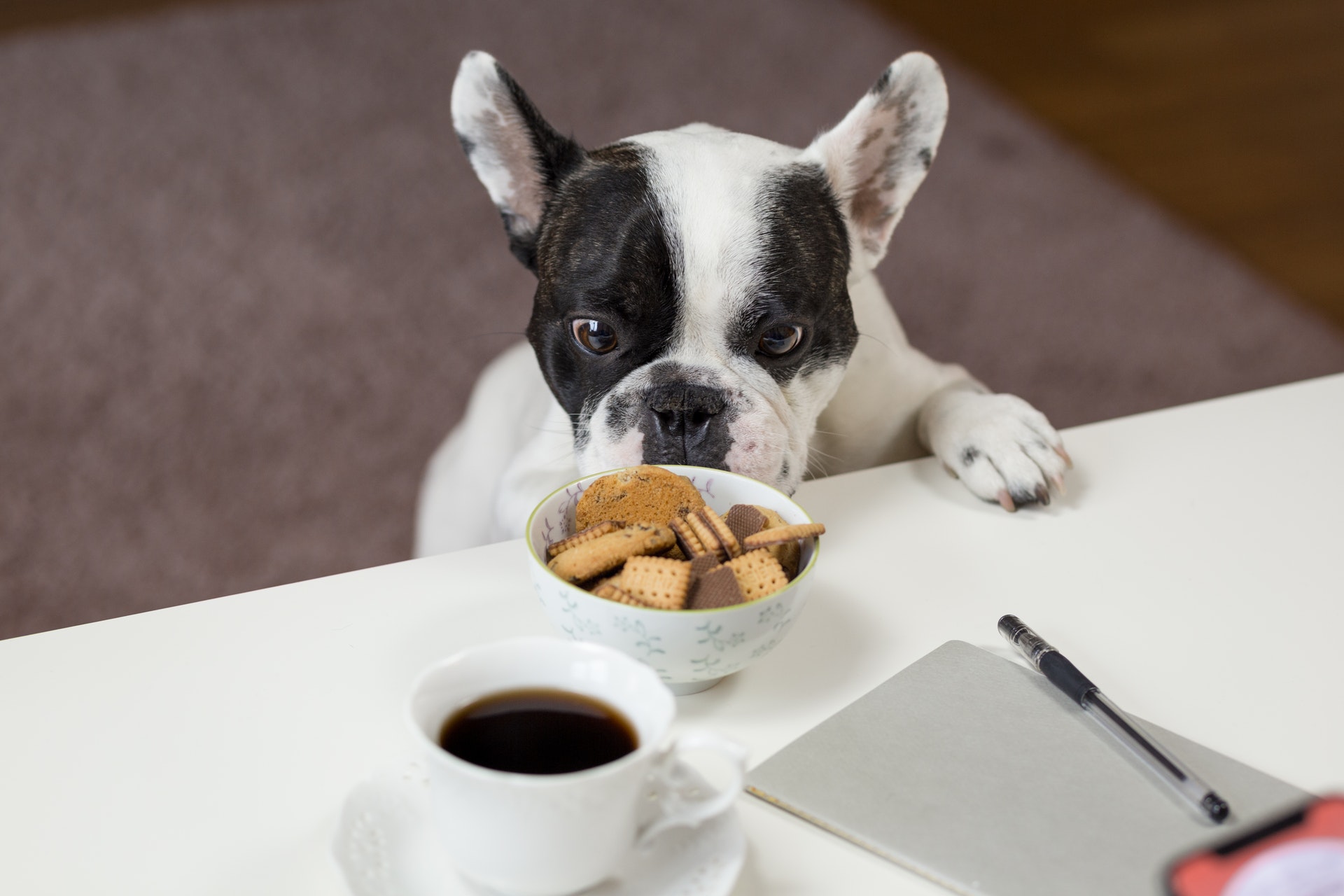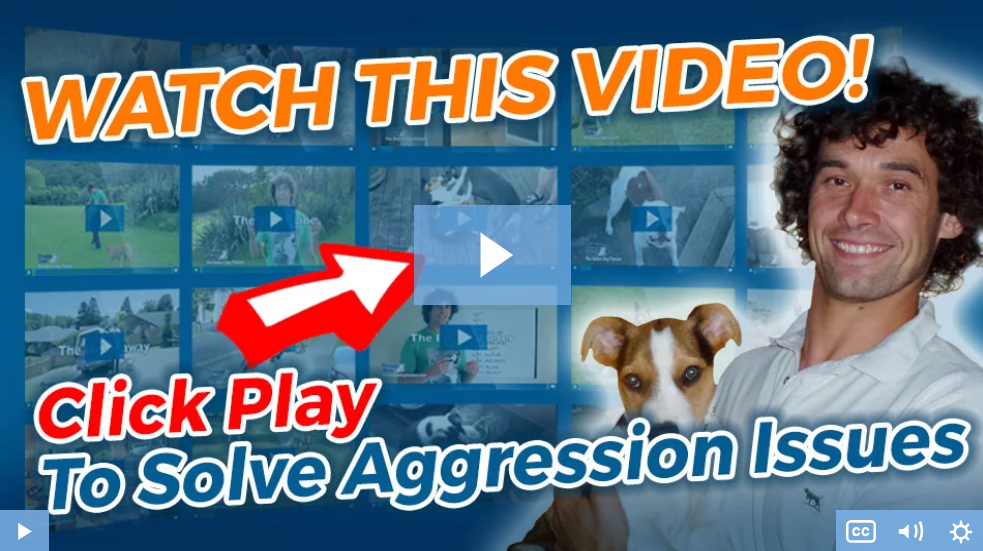If you want to learn how to stop food aggression in puppies you’re not the only one.
Because while we’d all like to think of our puppies as sweet innocent bundles of joy that can do no wrong, the truth is that dealing with behavioral traits like aggression can be a little shall we say, overwhelming.
But does this mean you should give up hope and let your pup set the rules in the kitchen?
In a word… No.
Thankfully, food aggression in puppies can be relatively easy to solve with the right plan of action.
The trick however with most things puppy-related is…
- Figure out why it’s happening
- Establishing pack leadership
- Consistency
Now, before we get into the do’s and don’t of stopping food aggression, first a quick heads up.
Dealing with any type of aggressive behavior starts by first teaching your puppy how to remain calm and in control of their emotions.
Because if you can ultimately teach your puppy to be calm, they’ll be less likely to act out in any situation that triggers their aggression.
So before you do anything else, take a few minutes to watch the short video below from Dan Abdelnoor over at The Online Dog Trainer.
During the video, Dan reveals exactly what to do, but more importantly, what NOT to do when it comes to calming the aggressive nature of your pup.
Watch the video, apply the training Dan recommends into your dogs’ routine consistently, and you’ll see a marked improvement in their behavior in a short space of time.
Here’s the link to take a look: Click Here To Discover How To Finally Stop Your Puppy’s Food Aggression Problem In Minutes… Even If You’ve Tried & Failed Before!
(video will open in new window)
What Is Food Aggression In Puppies?
The actual term ‘food aggression’ can be a little misguiding as it implies that the puppy is going to fight and demand food.
In most cases, it is actually best understood by considering it as a defensive or protective behavior with the underlying threat of aggression.
Say for example you lay out your puppy’s bowl of food and then try to take it away.
Rather than passively accepting your decision without question, they instead snarl and bare their teeth.
And in the worst cases, they may even go to bite.
Should your dog exhibit any of the following characteristics when feeding then it is time to be on the lookout for potential food aggression such as…
- Growling (with or without eye contact) when someone comes to close.
- Snarling at other dogs who try and encroach on their bowl.
- Adopts a ‘frozen’ and on edge posture when eating.
- Makes a snapping motion at you when removing their bowl – even if they do not actually bite.
- Eats especially fast and immediately looks for more food when their own bowl is empty.
- The whites of their eyes are especially pronounced.
You will be able to tell a puppy exhibiting signs of such aggression pretty easily.
Even if they still have their ‘baby’ teeth, do be careful as they can bite pretty hard and at such an age will likely not quite have figured out the difference between a nip and a snap.
Don’t worry though, it is surprisingly easy to train that little food fiend out of such antisocial behavior!
Just like any other aspect of puppy training, the necessary place to begin is by understanding what causes some pups to behave in this manner in the first place.
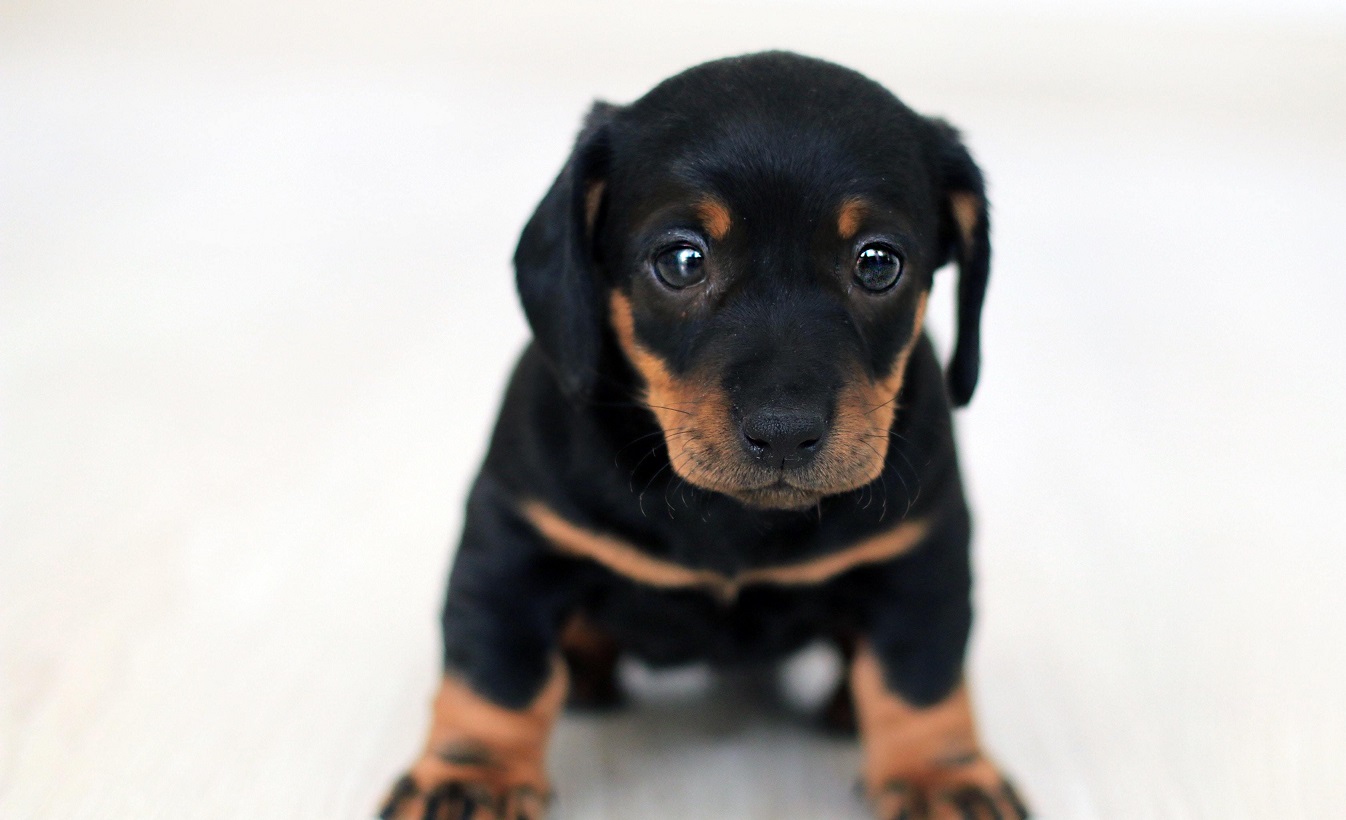

What Causes Food Aggression In Puppies?
So why do some puppies so aggressively protect their food when there is no threat that it will be taken from them?
The answer to this question basically comes down to canine nature.
Even that tiny ball of fluff retains some aspect of the pack mentality.
Back when dogs hunted in the wild, the Alpha leaders would exclusively have the first serving of the kill.
Once they were full to bursting, the rest of the pack could fight over the scraps – and naturally, this would cause quite a good amount of fighting.
This is basically the food equated to survival, so when a puppy is defensive over their bowl it is because of that retained natural instinct.
Sticking with the pack theory, there is also the fact that before domestication dogs simply did not know where or when their next meal would be coming from.
It could be the same day, but more likely would be days later, many miles away and involve an energetic pursuit and kill.
Lacking the energy to keep up or contribute to the hunt would simply move them even further down the dining pecking order.
So missing just a single meal – or even worse having it taken/stolen away, could make the difference between life and death.
How do we know this for sure?
Well, much as some dog owners may scoff at the sheer notion that some dogs are still hardwired for the pack mentality. There is clear evidence that proves this still today.
Take a look at some of the countries where feral dog packs are still common in both urban and rural environments.
It is clear that there is an established eating order regardless of who claims the kill.
And that order is…
Alphas always dine first.
Even packs that are clearly full to bursting will defend leftover carcasses from other scavengers as of their lives depended on it.
This is because, from the dog’s perspective, food supply is the most important thing in the world.
While there may be a world of difference between a Nepali scavenger dog and your suburban fluff-ball, they share that common principle and defensiveness towards their food.
But why do they defend their food from those who supplied it?
This is a common question and one that humans can struggle to comprehend.
From their perspective, your family is their pack.
While they will be happy to be subservient to the Alpha (you) who supplies the food, their attitude towards everyone else is up for question.
Ever wondered why some dogs are doting and loving to some members of a family yet couldn’t care less for others?
It is because they have not established themselves as above the dog in the pecking order.
The same is true when other dogs come to ‘visit’. Watch your dog’s behavior – the second thing they’ll do after establishing a friend or foe is to check that their bowl is empty just in case it is stolen!
So while the family may provide the food, they only care immediately for the one who hands them their bowl.
Sure, there are many other ways whereby Alpha dominance can be earned but food supply would be placed at #1 on most dog behavioralist’s lists.
(video will open in new window)
Other Reasons For Food Aggression In Puppies
There are many reasons why dogs may exhibit food aggression as youngsters.
Some breeds are naturally predisposed towards defensiveness – it’s why they were domesticated in the first place.
For example, German Shepherd, Rottweiler, and Doberman puppies are almost always going to exhibit signs of aggression.
Working that out of their ‘programming’ is one of the first considerations when setting about early training these breeds.
But the problem can manifest itself in all breeds and it is never safe to assume that your otherwise placid pup will not become a little monster at dinnertime.
Even puppies can be prone to early onset PTSD.
Many rescue puppies – especially those saved from especially traumatic circumstances – will often exhibit nervousness around their food supply.
It is natural for them to subsequently defend it as they deem appropriate.
Likewise, do not rule out the outside chance that your puppy may be experiencing pain while eating and is, therefore, more prone to out of character aggression.
In puppies, this is usually due to gastric issues or possibly teething problems.
While possible, unless there are any other overt signs of distress save a trip to the vet until you have tried the following guide to eliminating your puppy’s food aggressiveness.
How To Stop Food Aggression In Puppies
The first step to take when it has become apparent that your puppy is displaying food aggression characteristics is to establish the severity of the problem.
Are they solely defensive around food, or does that extend to possessiveness over toys, sleeping/resting spots, or even other dogs and people?
If the latter appears to be the case then the dog is either displaying what is termed ‘resource guarding’ or even worse, displaying insubordination to the Alpha (you).
Either way, you need to take the lead here.
A fearful dog prone to snap over food anxiety needs to be reassured, an ambitious/ill-disciplined dog needs to be reminded carefully who is boss.
In exceptional cases, (and we’re talking one puppy in a thousand) where the puppy becomes immediately aggressive to the point of attacking people who even step into the room while they are feeding. It is sensible to immediately consult local behavioral specialists.
It’s important to understand that at no stage of this training should anyone be at risk of being bitten.
Assuming that your puppy is otherwise mellow and non-aggressive, we’re seeking to establish three things with this training:
- Desensitize the puppy to the presence of other people/dogs when they are feeding.
- Form a positive association between people and their food.
- Train out specific food aggression behaviors by providing incentives.


Desensitizing Your Dog
In the overwhelming majority of cases, your puppy is going to become aggressive due to the proximity of others to their food bowl.
Therefore, we need to slowly work towards lessening this distance without causing your pup to exhibit any of the warning signs listed at the top of this article.
We do this by ignoring the dog entirely and going around our business while slowly inching closer to the feeding area.
Do not rush this – take it gradually and work at it over a couple of weeks.
Just stay distracted – make your own breakfast, chat with other household members – anything which the pup will interpret as non-threatening towards their food bowl.
Just try and keep it standardized and consistent (which is why making breakfast is a sensible choice).
The idea is to get within a couple of yards over the next few weeks.
If this is impossible without your dog snarling, barking or displaying aggressive body language then it may be time to consider calling a professional.
Chances are that the puppy will be displaying other anti-social tendencies and these need to be ironed out ASAP otherwise you will end up with a difficult adult dog.
But let’s not give up just yet.
Try the following first…
Use Treats For Positive Reinforcement
As far as your puppy is concerned, that bowl of food is essential for their survival.
Only one thing is going to potentially lure them away from it – an even tastier treat!
While performing the above method, casually toss occasional treats that will land just far away enough for them to have to leave their bowl unprotected. Make sure they are irresistibly better than their standard feed.
They will swiftly notice what you are doing and that there seems to be an unlimited number of those treats available.
All they need to do to enjoy more and more of them is to come ever closer to you and leave their food bowl unguarded.
Once they have figured out that even after a tasty extra nibble that their primary meal is not going anywhere, chances are that they will considerably mellow out.
How far you wish to stretch this is up to you, but it does also present a perfect opportunity to make your puppy comfortable eating out of your hand.
Once your puppy is happy with this, you are well on the way to eliminating that food aggression.
So it’s time to step it up a little…
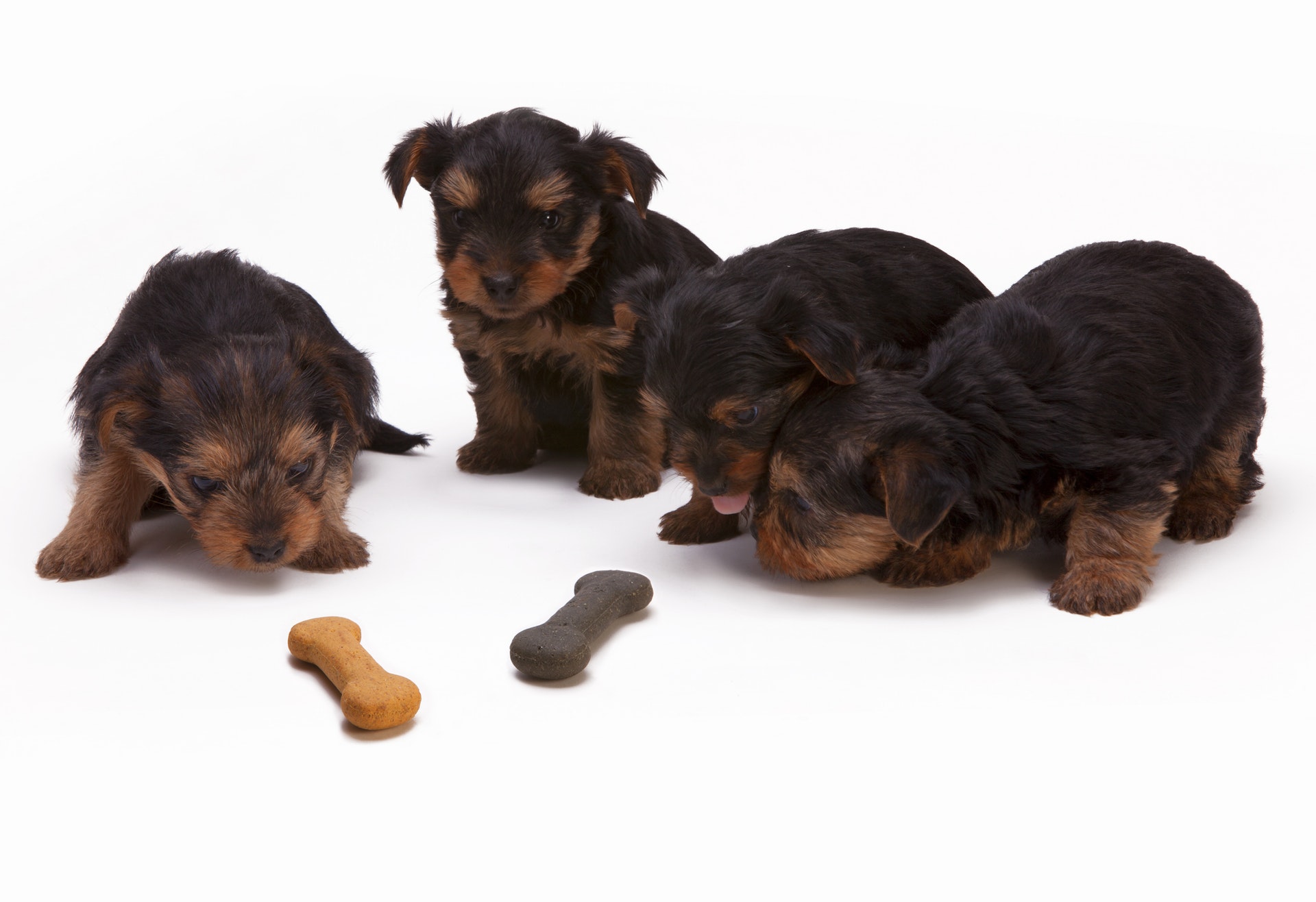

Remove & Replace The Bowl
We’re now working on the assumption that your dog is willing to eat treats from your hand.
But be aware that they do not understand the concept of “do not bite the hand that feeds”.
Assess your situation carefully before attempting this and only attempt it if you can stand right next to your dog while they eat and there are no signs of aggressive tendencies.
Start by lowering yourself onto your knees and gauge their reaction.
From their perspective, this will be unusual but ideally, they will just go “yeah, whatever” and carry on with their meal.
Very carefully put your hand on the bowl and lift it up as you straighten back to a full stance.
Your dog will wonder what is going on, but hold it for five seconds and then replace.
Next meal time, try this twice and leave it ten seconds before replacing.
Then try it three times and twenty seconds during the following meal.
There is no need to go any further than this (you don’t want to make them unduly angry).
Ideally, your dog will not be comfortable understanding that it is up to you to decide what happens with their food – and just as importantly, that there is nothing to fear.
Make Them Work For Food
It is easy for puppies to become complacent.
After all, as far as they are concerned life is all about food, play, and the occasional nap.
In some circumstances, this can lead to the accelerated prominence of unwanted behaviors including food aggression.
Most experts will agree that it is better to simulate the pack mentality by making your pup ‘work’ for their meal.
Key to this is exercise…
Never feed your puppy before walking (it can cause dangerous bloating) and make sure that the exercise is just the right side of ‘more than enough’.
Your dog ought to be tired when they get home, and hungry.
But keep your hands off that bowl!
Now you feed yourself and your family.
Your dog will be extremely hungry and waiting for its share down the pecking order.
Once everyone has dined, give them some positive love and feed them.
Combined with the exercises above you will be reinforcing in your pup’s mind your control over when and how much they eat.
It is unlikely they will ‘play up’ to risk their share – and consequently, they ought to be less aggressive around feeding times.
Just remember that if you have more than one pup to treat both of them equally and keep a lookout for any thieving or bullying.
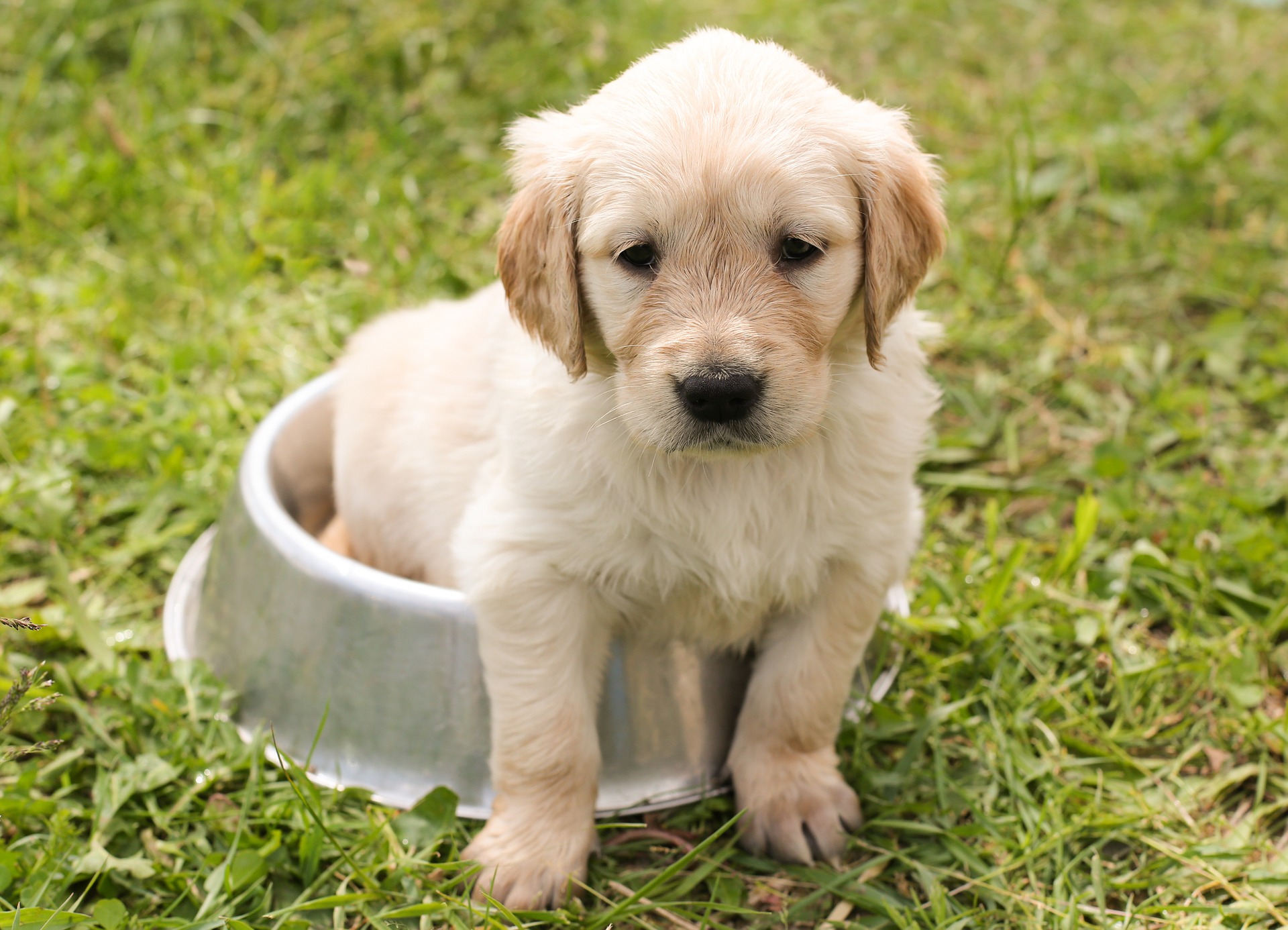

Final Thoughts
Food aggression in puppies can quite easily be worked out providing it is caught and acted upon early.
Early socialization is where your pup figures out the rules, and as creatures of habit they will quickly learn what they can and cannot get away with.
Keep mealtimes and even more so the rules always consistent and ensure that all members of your household are aware of them.
Your pup will come to realize that their new pack is pretty darn good at this hunting business – so much so that they are always going to get their share of the hunt.
Do not read too much into breeds when it comes to food aggression.
While there is no doubt some are more prone to it than others, this is such a common issue that it will materialize in more puppies than not.
Just think how many times you have visited a friend’s home and been told to “stay away from Fido” when they are eating?
The whole reason for that comes simply down to poor training as a puppy, and for something so easy to remedy it really is quite a pity.
If you would like to add to your own experiences or advice regarding food aggression in puppies, please feel free to post away in the comments below…
(video will open in new window)
